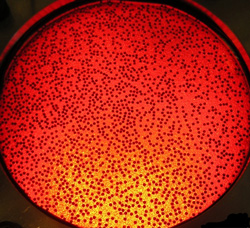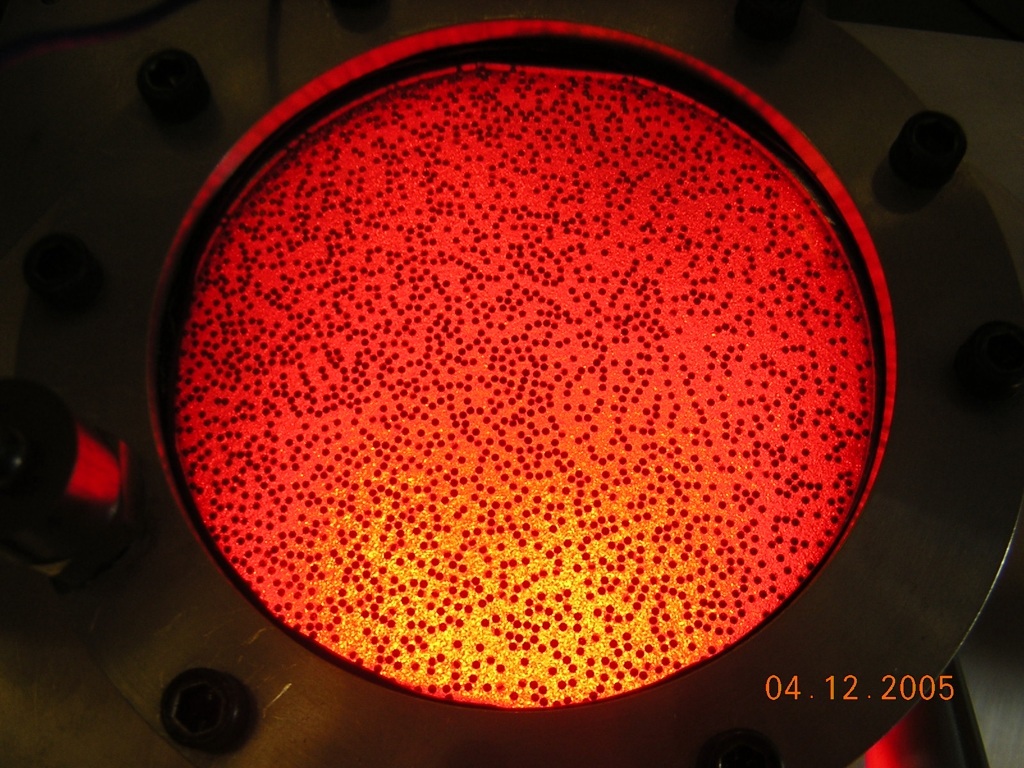Shaky Equilibrium
Grains shaken on an uneven surface can freeze into crystal structures, according to the 30 June PRL. Although researchers have observed similar transitions before, this study is the first to show that the details of the transition–such as the conditions for crystallization–mimic the properties expected for real crystals. The surprising similarity may mean that complicated arrangements like avalanches, pharmaceutical powders, and even living cells may be amenable to the basic physics principles that describe simple gases and fluids.
The textbook theory of thermodynamics allows theorists to calculate the properties of a material, like its temperature and pressure, without needing to follow the countless interactions among its molecules in detail. “The theory tells us everything important about a system under one condition: the system must be in equilibrium,” says Mark Shattuck of the City University of New York. The hallmark of equilibrium is an equal exchange of energy between the system and its environment. And yet, many natural phenomena, like flowing grains and plasmas, constantly lose energy through friction or heat-dissipating collisions.
Researchers studying granular materials like sand or ball bearings hope to come up with a theory like thermodynamics for such non-equilibrium systems, in part because they could address problems in geological and industrial settings. Experimenters have observed the “grains” in granular materials forming crystal-like patterns when shaken, but the results have been hard to model theoretically or to compare with equilibrium phenomena. “We don’t have predictive models for grains, like we do for gases and fluids,” says Pedro Reis, who recently moved to the Institute of Industrial Physics and Chemistry (ESPCI) in Paris. To better understand the grain behavior, Reis, Shattuck, and their colleagues decided to measure the crystallization over a wide range of densities–a better parameter than temperature for comparison with computer simulations.
The researchers chose 1.2-millimeter-wide steel balls. They placed them inside a closed, transparent, horizontal disk just thick enough that the tiny spheres could move up and down slightly. The team shook the disk vertically at 50 hertz (50 cycles per second). Unlike most similar experiments, the “floor” of their disk was roughened through sandblasting, so it gave random horizontal kicks to the grains whenever they bounced–a way of randomizing the injected energy.
Using a high-speed camera, the researchers tracked the positions of grains in a region of the disk. At low density, the grains flew around like a diffuse gas, but as the density increased, they suddenly switched to an ordered crystal pattern. This transition density was nearly identical to the one others have observed in computer simulations of an idealized two-dimensional fluid in equilibrium, the authors report. In addition, over a wide range of densities, they found that several measures of the degree of crystallization–such as the geometrical shapes formed by each particle’s nearest neighbors and the correlations between particle positions–were remarkably similar to equilibrium simulations. This close correspondence implies that the grain interactions obey the same overall principles as do systems in thermodynamic equilibrium, the team writes.
The equilibrium-like properties are a big surprise, says Douglas Durian of the University of Pennsylvania in Philadelphia, because the continuous addition of energy to the granular fluid was thought to bias how the grains would interact. Instead, “the uniform way we inject energy [using the roughened surface] seems to be more important than energy conservation,” says Reis.
Most non-equilibrium systems do not have such a uniform supply of outside energy. But Durian thinks that studying simple steady state scenarios, like this one, may provide the intuition for applying a thermodynamic framework to harder problems, like those in cell biology and the pharmaceutical industry.
–Michael Schirber
Michael Schirber is a Corresponding Editor for Physics Magazine based in Lyon, France.





